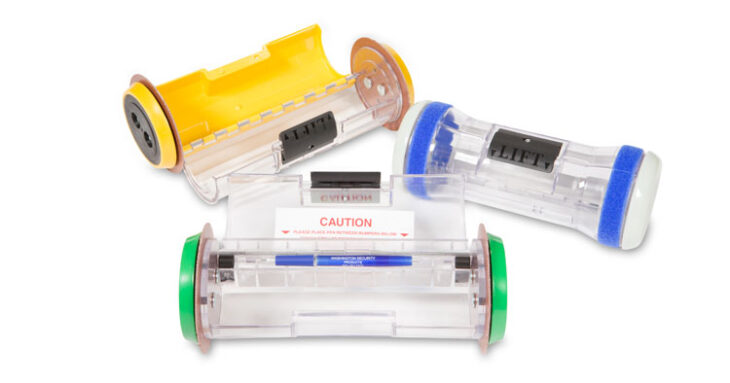Pneumatic tubes are something we often see in the movies, and probably at least one of us has ever asked how it works, or is it really useful in real-life? How it’s used? Which industries may benefit from it? Can it be somehow applied to today’s financial sector?
First, we need to explain how the pneumatic tube systems work, and how they can be used in different industries and departments in the economy. The tube is made of solid plastic or metal, and it usually has a cylindrical shape, so it can easily go through the transport tube. Once you put the cash or other good in the canister (the cylindrical tube), and it needs to be transported somewhere near, you can use the tube system to do that. The air will “suck” the tube, and use the vacuum method to lead it to the trace it needs to pass until it reaches the wished distance. You only need to choose which way the air will suck it, and enter the code of the output, and then load the system. All the movements are directed by the air, that blows the canister through the trace until it reaches the goal.
On websites like wasecurity.com you can find a lot of options and recommendations on how this technology can be used in so many ways in hospitals, and even banks and finances, to carry money that should be transported to another unit, without having to organize external transportation, that requires a special vehicle, and human resources to secure the whole process.
How these systems may benefit the banks? We will try to explain it in this article.
Contents
1. They are simple and reliable

Image source: wasecurity.com
Most of the time, these systems are installed in banks for internal use. In huge buildings, sometimes it’s not practical to go from one office to another, so you can find the co-worker you need and give them some documents or cash, or ask them for something you need immediately. The tube is also safe even for the fragile things because the air ensures you it won’t break by hitting the tunnel walls, because all the process is air-cushioned, and the package will hit the final distance without being “hurt” through all of that.
2. The banks are using it for a long time

Image source: unsplash.com
According to some data, the pneumatic tube system is widely used since 1893 around the world. Today, we have a digital transfer of money and e-banking, but these systems are still active and used, especially between the employees in the banks.
3. It can be also used for money transfer
Not every citizen knows how to use the ATMs, and elder ones are afraid that it may steal their card, so they are choosing to wait in the lines in the bank, and talk to the employee, tell them what they need, and get their money in hand. The pneumatic tube system can be very helpful in this case, because the employee can just message the responsible person for that, and the money can be taken from the safe and brought to the customer in a few minutes. It’s also a very safe way of transfer because the cash never gets out of the bank, and there is no risk of robbery on its way to the consumer.
4. Safety and security for cash transfers

Image source: unsplash.com
Sometimes, some banks are connecting some of their offices through pneumatic systems, so they can make an easy cash transfer, without leaving the building. As we already know, when cash needs to be transported from one point to another, with a vehicle, it can easily become a robbery target, that results in great money loss. So, the tube systems we are talking about are practical for cash transfers, because sometimes some transactions can’t be performed through the bank accounts. By using this not-so-new technology, you can be sure that, as we previously said, the money will stay inside the building, without putting them at risk to be stolen on their way.
5. Employees can use it to send and receive documents

Image source: unsplash.com
Before the digitalization, most of the files were kept in hard-copy in the bank’s archive. Some users are loyal for decades, and their files are still there, and sometimes they need to open them, to see the credit history or their money activity in the past. The best way to get to the file is to choose a pneumatic transfer if it’s possible, but many banks are embracing that way, so they can complete the client’s requirements without sending them from one office to another.
What are the other industries that may benefit from this technology?
Today, many industries and branches are using the pneumatic seals, together with the hydraulic systems in so many ways. They are fixed internal installations, that use the compressed air to transfer the goods from one point to another, without having to use the employees or clients to take it from one place to another.
For example, they are widely used in big hospitals and clinics, so they can send the blood samples directly to the lab for an examination, or get the proper treatment for the patient. Sometimes, only a few seconds are needed to save someone’s life, and these carriers are ensuring that the doctor will get the right pills or injections in a few seconds. That leaves more time to dedicate to the patients, without having to take care of the formal parts, like signing documents and hospital history, when they have a life to save. It works in a similar way for the pharmacy industry, especially where the drugs are produced.
Anyway, we can say it works the best in cases when some goods need to be quickly transported from one point to another, without having to make all of that formal, requiring the security to ensure the process is safe. For cashless transactions, the e-banking is still a leader, but when it comes to cash transfer, these systems are mostly recognized as the most secure way of all.
